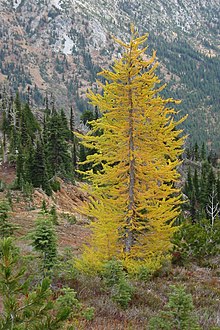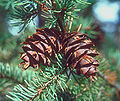Laricoideae
| Laricoideae | |
|---|---|

| |
| Scientific classification | |
| Kingdom: | Plantae |
| Clade: | Tracheophytes |
| Clade: | Gymnospermae |
| Division: | Pinophyta |
| Class: | Pinopsida |
| Order: | Pinales |
| Family: | Pinaceae |
| Subfamily: | Laricoideae (Rendle) Pilg. & Melch. (1954) |
| Type genus | |
Larix | |
| Genera | |
| |
The Laricoideae are a
Description
The
Taxonomy
The
]Historically the Laricoideae were the subfamily of the Pinaceae comprising the trees with needles inserted both on the macroblasts and on the brachiblasts; for this reason in the past they have been also included in it the genera Pseudolarix (for a short time) and Cedrus, subsequently eliminated following the most recent systematic updates developed on the basis of molecular genetic phylogeny, reproductive morphology, chromosome numbers and immunology. Currently, based on these studies, there are three genera in the subfamily Laricoideae, of which one of which is monotypic as it consists of only one species:[1]
| Image | Genus | Description | Living species |
|---|---|---|---|
 |
Larix Mill. |
temperate zones or at high latitudes in the Northern Hemisphere. They are found in North America, Central Europe and Northern Asia (Russia, Japan and China ). |
|
 |
Carrière |
Eastern Asia, where they can reach 100 m in height (Pseudotsuga menziesii var. menziesii ). |
|
 |
Cathaya Chun & Kuang | Monotypic Cathaya argyrophylla. The leaves are needle-like, evergreen, 2.5–5 cm long with ciliates margins when young; they grow in spiral patterns around sprig. Cones 3–5 cm long with 15-20 scales, each scale bearing two winged seeds. This conifer grows in Southern China, in provinces of Guangxi, Guizhou, Hunan and southeast Sichuan on steep mountain slopes between the 950 and 1800 m of altitude. |
|
Within the
and the presence of an exine shell during microgametophyte germination. Doyle and O'Leary (1935)Price et al. he supposed in 1977 that the Laricoideae were a
Dichotomous key
The
|
1. Laricoideae (includes
|
Revisions and research
According to the latest research still in progress,
For other authors, finally, the
See also
- Pinaceae
- Abietoideae
- Pinoideae
- Piceoideae
- Larix
- Pseudotsuga
- Cathaya
- Subfamily
References
- ^ a b c d e Earle 2018.
- ^ "Douglas-fir: Tallest Tree in The World?". Vancouver Island Big Trees. 6 July 2011. Retrieved 2020-02-13.
- ^ "Subfamily Laricoideae (Rendle) Pilger & Melchior". BioLib. Retrieved 2013-05-19.
- ^ Farjon, A. (1990). Pinaceae: drawings and descriptions of the genera Abies, Cedrus, Pseudolarix, Keteleeria, Nothotsuga, Tsuga, Cathaya, Pseudotsuga, Larix and Picea. Königstein: Koeltz Scientific Books.
- ^ a b c d "Pinaceae", Missouri Botanical Garden Taxonomy, Missouri Botanical Garden, retrieved 2018-01-05
- PMID 19477895.
- PMID 20651328.
- ISBN 978-0-691-14580-8.
- PMID 10779538.
- S2CID 52110440.
- ^ ISBN 978-88-299-1824-9.
Bibliography
- Picea. Aljos Farjon. Koeltz Scientific Books, 1990 - 330 pages.
- Earle, Christopher J., ed. (2018). "Pinaceae". The Gymnosperm Database. Retrieved 2013-05-19.
- Lin, C. P; Huang, J. P; Wu, C. S; Hsu, C. Y; Chaw, S. M (2010). "Comparative Chloroplast Genomics Reveals the Evolution of Pinaceae Genera and Subfamilies". Genome Biology and Evolution. 2: 504–517. PMID 20651328.
External links
- Taxonomicon.nl Subfamily Laricoideae on taxonomicon.nl
- The Gymnosperm Database – Pinaceae (subfamily Laricoideae)
- Laricoideae in Pinaceae (Missouri Botanical Garden)
- Subfamily Laricoideae - (Rendle) Pilger & Melchior in BioLib.cz
